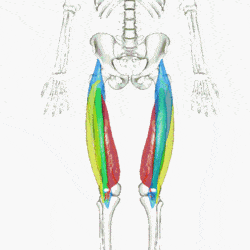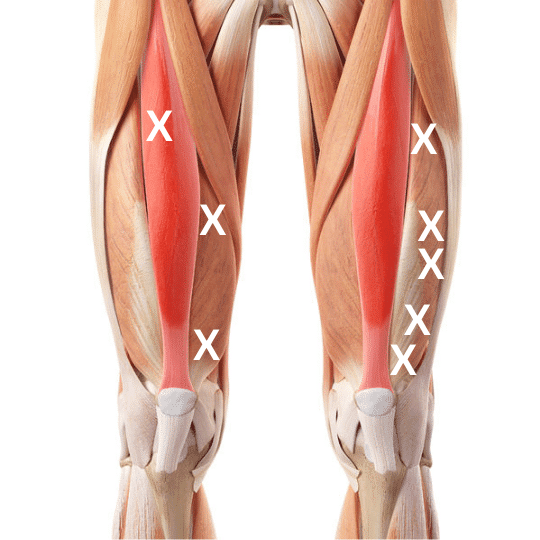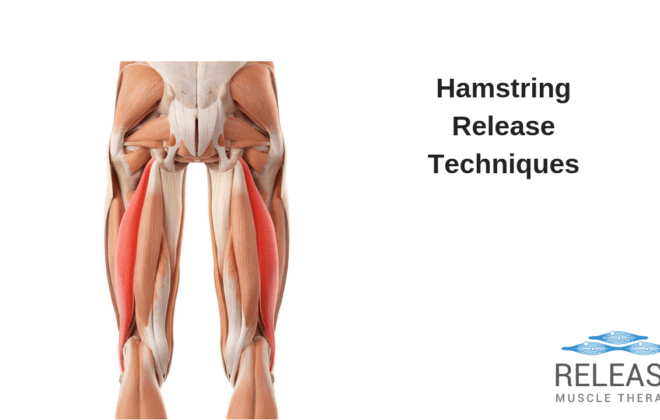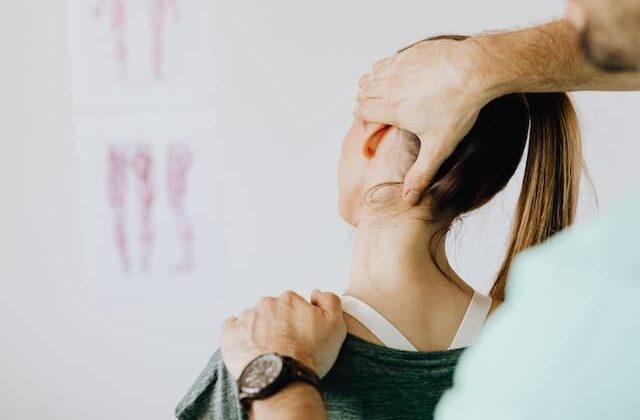Quad Trigger Points | How To Find And Treat
If you’re dealing with quadricep or knee pain, then identifying and addressing quad trigger points is an important step in a comprehensive therapy program.
We delve into identification of trigger points, self-treatment strategies, and techniques for stretching and muscle energy. By offering a scientific, analytical perspective, we aim to aid practitioners and patients alike in effectively managing quad trigger points.
Here is what we are going to cover in this guide:
-Overall anatomy and function of the quadriceps muscles
-Location of quad trigger points
-Typical symptoms that are experienced and overlapping conditions
-Potential causes, and how to self-treat these trigger points
The Quadriceps Muscles And How They Work

The quadriceps muscles, often referred to as ‘quads’, play a crucial role in carrying out the hinge-like movement of your knee, enabling walking, running, and jumping with ease.
They originate from various quadriceps attachment points, including the femur and the hip bone, before inserting onto the tibial tuberosity through the patellar ligament, which lies just below the knee joint. There are 4 muscles that form the group:
-Rectus femoris (this is the only one that moves the hip and knee!)
-Vastus lateralis
-Vastus medialis
-Vastus intermedius
The quadriceps are responsible for knee extension and hip flexion (only the rectus femoris does this one) – crucial movements in everyday activities.
Quad Trigger Points – Where Are They Located?
Trigger points in the quads are typically found in four key areas within the muscle group.

The vastus medialis and vastus lateralis, found on the inner and outer aspects of the thigh respectively, often contain very tender trigger points. Similarly, the rectus femoris and the vastus intermedius, located centrally, can also hold some important points.
Understanding the precise location aids in effective quad trigger point release, alleviating pain and improving muscle function. It’s crucial to remember that each individual may have a unique distribution of quadriceps trigger points, requiring a personalized approach to treatment.
Symptoms Associated
Recognizing the symptoms associated with quad trigger points plays a vital role in both getting to the root cause of the problem, as well as selecting the right therapy protocols.
The manifestation of a trigger point in quad muscles typically results in localized pain or discomfort. This may be accompanied by muscle stiffness or a palpable “knot”, often referred to as a quad muscle knot.
It’s important to note that the severity of symptoms can vary greatly from individual to individual. Some individuals might experience mild discomfort, while others may report deep aching pain. Furthermore, these “knots” in quads can lead to limited mobility in knee flexion, muscle weakness, or even muscle twitching.
In some cases, quads trigger points could also cause referred pain that radiates to other areas. This is especially the case when it comes to anterior knee pain and patellar tendon.
Causes And Treatment Options
Overuse, trauma, or strain are common causes for trigger points in quads. A sedentary lifestyle can also lead to de-conditioning and tension in the quadriceps.
To relax the quad muscles, physiotherapy, stretching, and massage are often generally recommended. Trigger point therapy or myofascial release techniques can be used to release quads, focusing on specific quadricep trigger points.
If symptoms persist even after these interventions, the trigger points themselves may not be the primary contributor to the issue, and additional sources should be ruled out.
Differential Diagnosis – What Else Could It Be?
Differential diagnosis plays a crucial role in ruling out other potential causes of discomfort in the quadriceps.
A detailed clinical examination often reveals tense bands of muscle fibers, often associated with trigger points in the thigh. However, the presence of a muscle knot in the quad does not necessarily confirm a trigger point.
It’s essential to differentiate between simple trigger points and other pathologies such as strains or tears.
Hence, a comprehensive differential diagnosis is paramount in accurately identifying and treating quad trigger points. This should be performed by your primary healthcare provider.
How To Self Treat
Self-treatment methods for quad trigger points, when applied correctly, can effectively alleviate discomfort and enhance muscle function.
The first step in how to self-treat these muscle “knots” is identifying the specific trigger points. Once identified, you can use various techniques to release them.
These techniques can include self myofascial release with a tool such as a foam roller, tennis ball, lacrosse ball, etc., muscle energy techniques, or ice therapy with stretching.
Stretching quadriceps muscles aids in relaxing the tense muscle fibers and promoting blood circulation. It’s vital to maintain a gentle, consistent stretch for maximum benefit.
Stretching The Quadriceps
Incorporating regular quadriceps stretching into your routine can significantly assist in relieving the tension from quad trigger points. The standing quad stretch, for instance, is very easy to perform, and get the job done efficiently.
The standing quad stretch can be done for 2-3 repetitions on each side, holding for 30 seconds each. This can repeated 1-3 times per day.
Regular practice of this stretch can help get the self massage work to “stick”, improve range of motion, and reduce likelihood of the issue in returning.
Muscle Energy Technique For The Quads
Muscle Energy Technique (MET) is a type of manual therapy that uses the patient’s own muscle energy (i.e., their force) to improve joint mobility and muscular function. Here’s how it works:
- Isometric Contractions: The therapist positions the quadricep into a lengthened position. The patient is then asked to contract the quad against a counterforce provided by the therapist. This is done in a controlled and gentle manner. Only about a 15% effort is generally required.
- Relaxation & Stretching: After the isometric contraction, the muscle is allowed to relax for a short period. The therapist will then move the tissues to their new range of motion, effectively stretching the muscle a bit further.
- Repetition: This process is repeated 5 or more times, until no further range of motion is achieved.
At the end of the technique, the previously tender trigger point is retested, for reduced sensitivity or de-activation.
Conclusion
Effective management of trigger points in the quadriceps encompasses various treatment options, including self-myofascial release, stretching, massage, and muscle energy techniques. However, a differential diagnosis is vital to rule out other conditions with similar manifestations.
Thus, comprehensive knowledge and appropriate intervention strategies are paramount for optimal outcomes.
Sam Visnic
Most Popular Posts
Categories
- Deep Gluteal Pain Syndrome (8)
- Deltoids (2)
- Foam Rolling (2)
- Glutes (9)
- Hamstrings (5)
- Hypnosis for Pain (3)
- Lats (2)
- Levator Scapulae (4)
- Lifestyle (8)
- Massage Therapy (39)
- Mobility (21)
- Movement and Exercise (19)
- Muscles (22)
- Nutrition (2)
- Obliques (1)
- Pain (25)
- Pectorals (3)
- Piriformis (3)
- Plantar Fasciitis (11)
- Psoas (11)
- Quadratus Lumborum (3)
- Quadriceps (2)
- Rhomboids (3)
- Sciatica (1)
- Serratus Anterior (1)
- SI Joint (14)
- Sternocleidomastoid (1)
- Stretching (18)
- Subscapularis (1)
- TMJ (2)
- Trapezius (1)
- Uncategorized (12)









